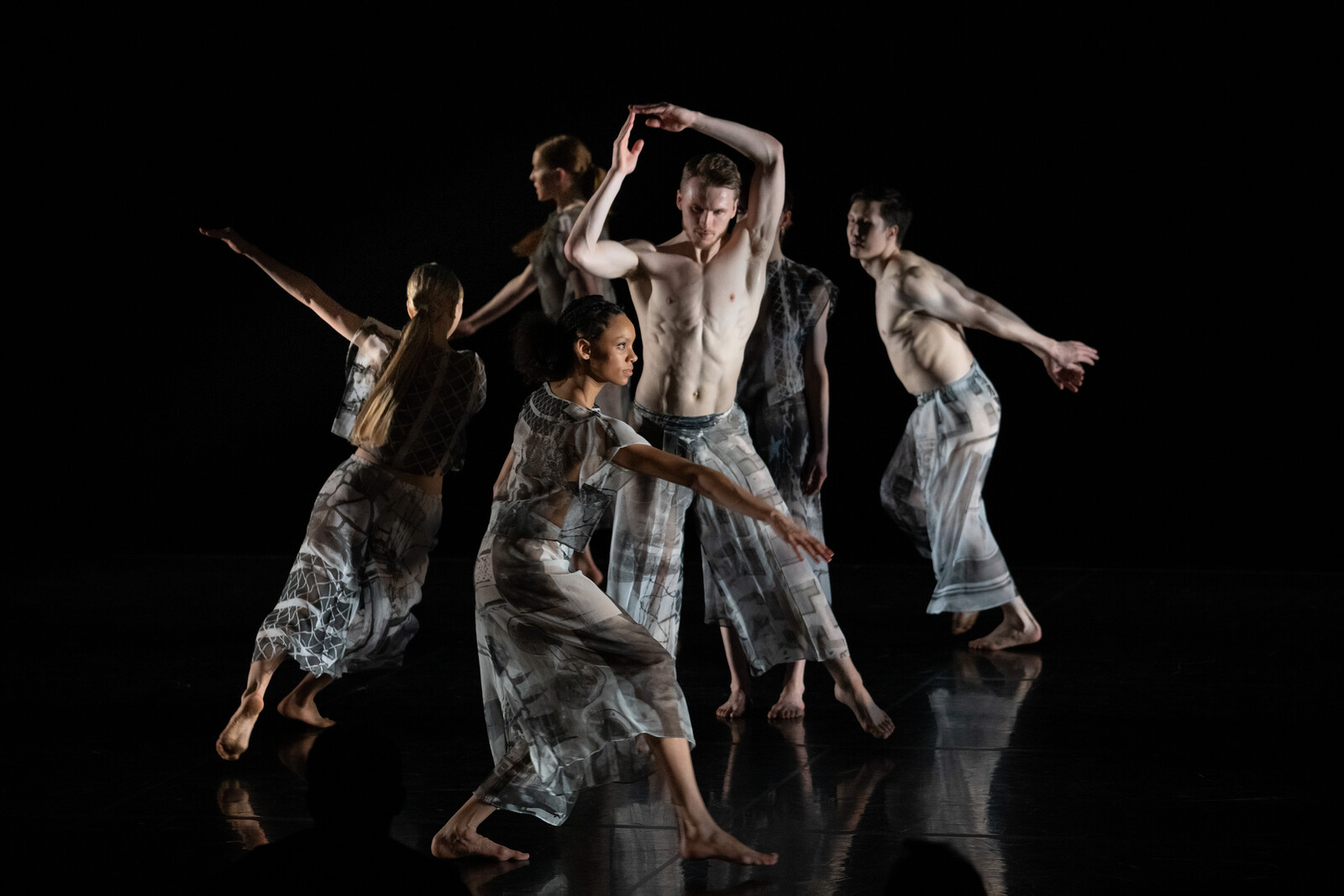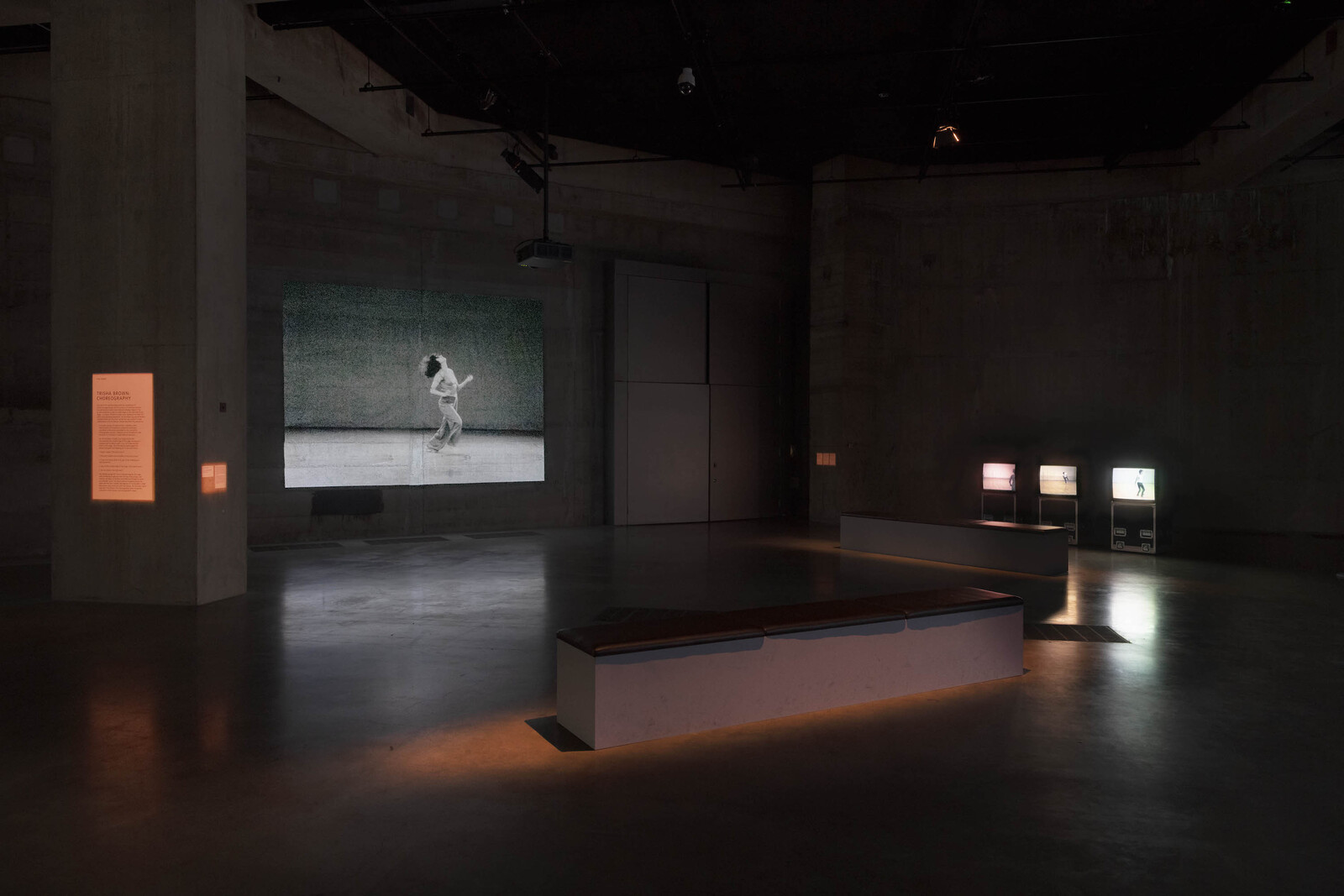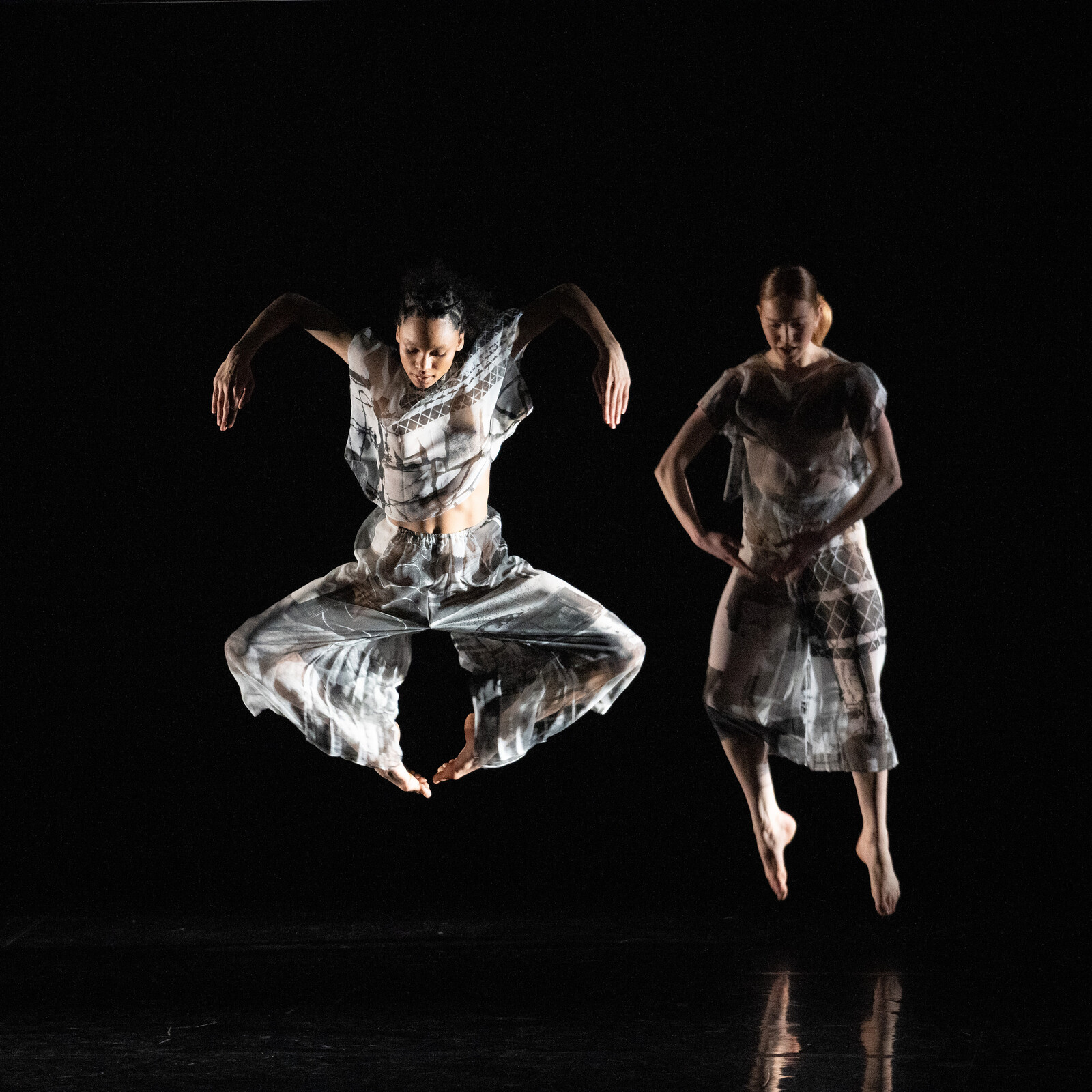“WORKING WITH BOTH TRISHA BROWN AND LAURIE ANDERSON WILL BE ONE OF THE MOST UNIQUE THEATRICAL CHALLENGE [sic] IN MY CARREER [sic],” wrote Robert Rauschenberg prior to the production of Set and Reset (1983), in his signature uppercase. “THE EXPERTISE RELIES ON WHAT KIND OF ROOM WE MAKE FOR EACH OTHER. NO ONE COULD BE MORE CURIOUS ABOUT THIS THAN I AM.”1
Set and Reset premiered at the Brooklyn Academy of Music (BAM) in the institution’s inaugural “Next Wave” festival. The collaboration between Anderson, Brown, and Rauschenberg was funded by the National Endowment for the Arts—part of a new grants program supporting the interdisciplinary artistic collaboration increasingly evident in the city—and it became a commercial and critical success. Forty years on, the work headlines “Dance Reflections,” a new international festival of contemporary dance set across London’s Tate Modern, Sadler’s Wells, and the Royal Opera House. While the first festival iteration of Set and Reset elevated avant-garde performance from the ad hoc spaces used by Brown during the 1960s and ’70s onto the grand theatrical stage, this recent one re-grounded it onto a different space altogether: the museum floor. This marks another phase in the life cycle of avant-garde dance: its acquisition and exhibition by the contemporary art museum.
In the context of this multi-venue festival, the capacities and limitations of the art museum in the presentation of performance works became apparent, particularly when measured against comparable dance institutions’ restaging of other key postmodern works. More specifically, the festival format allows us to compare institutional architectures, which elicits a range of questions about the museum’s suitability and purpose in this field. What, for example, is the difference between seeing interdisciplinary productions in purpose-built auditoriums, and experiencing them in the modifiable space of the gallery? What view does each distinct infrastructure give us, and which perspectives risk being lost? With works such as Set and Reset, a fusion of various mediums, how might the hybrid model of performance-exhibition engage both theatrical experience and museum display? Or alternatively, how can the museum reconfigure or redetermine performance’s particular occupation of space and time?
Space was essential to Set and Reset’s production; Brown described it as exploring “relationships between figures both plastic and organic, about space, both physical and aural.”2 Rauschenberg designed its set and costumes, fashioning an interlinked pyramidal and cuboid framework that was covered with a reflective fabric developed by NASA, and elevated as an on-stage projection screen. He considered it a sculpture, and named it Elastic Carrier (Shiner) (1983). Onto it were projected his montages of excerpted news reportage, television shows, and NASA footage. For the dancers’ costumes, he silk-screened black-and-white images of New York City onto white gossamer fabric.
Also in conversation with Brown, Anderson recorded her exuberant, percussive Long Time No See (1983) which overlaid synthesized vocalisations with sounds of “cracks, bells, breaking dishes, buzzes, hisses and beeps.”3 Brown had set out to explore tensions between freedom and limits on stage by devising five central dance instructions: keep it simple; play with visibility and invisibility; get in line; stay on the outside edge of the stage; act on instinct. Sympathetic to the choreography, moving image, costumes, and sound, Beverly Emmons engineered the soft lighting that illuminated the stage wings’ transparent gauze fabric so that dancers’ constant regroupings were visible throughout.
Tate recently acquired Set and Reset in installation form from the Trisha Brown Dance Company, which has remained active since the artist died in 2017. The acquisition includes Rauschenberg’s costumes, set sculpture, and moving image, the rights to Anderson’s music, instructional “building tapes” from Brown’s rehearsal sessions, a video of the first performance at BAM, and photographic documentation. The opening of its display in Tate’s Tanks was activated by performances of the work scheduled over two successive weeks undertaken by two leading London-based dance companies: Candoco and Rambert. Guided by the TBDC, this was the first time the work had been licensed to another dance company, a handing-along that is part of what curator Catherine Wood has called the work’s “immaterial transmission.”4
In Rambert’s Set and Reset, the first movements are those of Rauschenberg’s moving images, projected on the elevated screen, which represent industrialization, city streets, clock towers, farm machinery, factory line workers. It’s a city symphony in embrace of modernity’s rhythms and choreographic commands, all set to Anderson’s glorious cacophony. Below it, Brown’s method of “memorized improvisation” informs dancers who split and coalesce in duos, trios, and quartets, form lines and scatter, rise, fall and push against the stage’s edge. Their limbs embrace and bump against one another or, in sudden bursts, seem to morph into pendulums or rods like human transforming into machine. While Rambert’s dancers inhabit Brown’s five core instructions and original costumes, Candoco took the piece’s phrase material and instructions as an anchoring device to be reworked with individual dancers as Set and Reset/Reset.5 Originally reinterpreted by Abigail Yager in 2011, Candoco’s version is inclusive of individual dancers’ multiple abilities and interlocking agilities, incorporating the dancers’ various prostheses (Joel Brown’s wheelchair or Marketa Stranska’s crutches, for example), which results in a piece of considerable virtuosity that seems uncannily attuned to Brown’s original intent.6
Watching the piece performed quite differently on this particular set, positioned at the centre of a repurposed oil tank to a hushed crowd of a hundred, felt precious. But as the dancers left the stage, the focal point returned to the various composite materials of the acquired installation (which remain on view until September). Moving between live work and these residual elements, the work’s material components and its choreographic dynamism are foregrounded in interconnected ways.7 Additionally, there’s a programmed series of performance lectures by Rambert dancers to demonstrate Brown’s core principles, methods that might otherwise remain undisclosed or obscure to audiences. This inventive reassigning of the theatrical, archival, and instructional materials that constitute Set and Reset’s acquisition keeps the material available to visitors and helps begin to distinguish how a museum might activate its dance collection in a way that is quite distinct to the ticketed, event-based, and time-limited programming of the theatrical venue or performance festival, or to the protocols of a theatre or dance archive.
This distinction becomes more pronounced within a festival that partners multiple dance venues showing repertory works. With similar fervour to Set and Reset, a restaging of Lucinda Childs’s Dance (1979) at Sadler’s Wells reminded audiences of how influential collaborations between choreographers, artists, and musicians have been to art and dance histories. Also premiered at BAM, this was Childs’s first full choreography, responding in three acts to Philip Glass’s undulating score. The first and last were created for eight dancers, the second for a female soloist. Performed here by the Lyon Opera Ballet, 17 dancers, dressed minimally in white, moved across the stage and one another’s paths with quick steps and lateral jumps, whirling, their elevated pathways drawing minimalism’s abstract forms on a white, grided, checkerboard stage. Superimposed upon this activity was a film, originally conceived for Childs by Sol LeWitt, projected across the stage on a gauze scrim. Shot at long and close range and edited it into split-screens, photographic stills, and intermittent fades, performers appeared to move in and out of time with their cinematic spectres. In this dance odyssey, movement and image divide and coalesce as fluvially as the choreographer reputedly intended (wanting to create a dance that viewers felt they could “slip into”). An immersive and visceral experience for the 1500-strong audience, it presented yet another reminder of the vitality of these historically consequential multi-part dance pieces and their relevance to innumerable artists working across mediums today.
Considered retrospectively, though, the viewing experience of this work was altogether different to that of Brown’s piece. Unlike Tate’s display, which fed the audience’s curiosity about the genesis of the piece after the event, Dance left viewers without immediate access to additional contextualization or the time to inspect the constituent elements of its earlier iterations. And possibly, for some repertory works, that’s preferable. But the contrast helps understand the museum’s potential relationship to dance, which although imperfect—without specialised auditoriums, rigging, seating, sound, producers, budgets, or ticketing economies to support extensive rehearsal or programming—retains a special and arguably unique capacity. This was articulated most convincingly with the remnants of collaborative and interdisciplinary dance work—moving image, sculpture, and fabric pieces—and most pressingly, as they age and potentially perish.
The collection and preservation of such components is important. And their display within the modifiable spaces of the art museum might accommodate new insights into the formal and platonic relations behind the works. Its daytime opening yields slow time for circulation and contemplation that’s complementary to the real time, night-time, sometimes too-fast time of the auditorium experience. Held in a collection like this, carefully and imaginatively, dance’s components might also be redetermined by diversely abled and equipped artists in yet-unimagined ways, establishing its place in art history while casting a line into art’s future.
In her effusive praise of Childs’ Dance after its premiere, Deborah Perlberg foresaw it creating “new perceptions on viewing not dance, not music, not film, but viewing totalities of such collaborative work which have as yet no name to describe them.”8 While this theatrical experience remains bracing and vital, the museum experience might stay open for the constituents that inform such totalities, encouraging new understandings and descriptions, and allowing a wide range of collaborators to, in Rauschenberg’s phrasing, “MAKE ROOM FOR ONE ANOTHER.”
The Dance Reflections by Van Cleef & Arpels Festival, developed in collaboration with Sadler’s Wells, the Royal Opera House and Tate Modern, ran from March 9–23, 2022.
An excerpt from Robert Rauschenberg’s handwritten letter of recommendation for Laurie Anderson and Trisha Brown, and their collaboration on Set and Reset for a National Endowment for the Arts grant application, September 15, 1982. Rauschenberg was dyslexic and frequently wrote letters and other notes in upper case. https://www.rauschenbergfoundation.org/art/archive/letter-recommendation-trisha-brown-and-laurie-anderson-set-and-reset.
Trisha Brown, application, National Endowment for the Arts Inter-Art Grant for period April 1983–April 14, 1984, Trisha Brown Dance Company Archive, New York. Quoted in Susan Rosenberg, Trisha Brown: Choreography as Visual Art (Connecticut: Wesleyan University Press, 2016), 266.
On Anderson’s musical, Rosenberg consults Allen Fogelsanger’s “On the Edges of Music: Trisha Brown’s Set and Reset and Twelve Ton Rose.” Rosenberg, note 13, 266.
Catherine Wood, in correspondence with the author, April 2022.
Using Brown’s original phrase material and core instructions, they have been strung “together to make different sequences or patterns.” From Set and Reset Guide, produced by Candoco (last accessed April 2022): https://candoco.co.uk/events/set-and-reset-reset/.
Yager’s process was based on Lance Gries’s earlier deconstruction of Brown’s piece for pedagogical purposes in the late 1990s at P.A.R.T.S., Brussels.
Wood stated from the outset her concern that the museum might fix “works of art into a static shape upon collecting them,” or that “preservation means stopping time.” All quotes from the curator’s statement in Dance Reflections brochure, 10.
Deborah Perlberg ,“DANCE”: LUCINDA CHILDS, PHILIP GLASS AND SOL LEWITT, Artforum International 18:5 (1980), 53.




